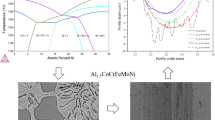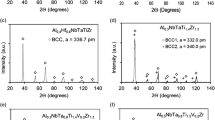Statistical studies on the stability of the mechanical properties of various semifinished products made from Ti–6Al–4V alloys depending on the content of alloying elements and impurities after annealing under factory conditions have been conducted. Results show that the influence of each alloying element and impurity may be insignificant, but their combined effect in terms of aluminum and molybdenum equivalents leads to a significant variation in properties. The influence of the chemical composition in terms of aluminum and molybdenum equivalents, as well as simple annealing modes, the difference between the polymorphic transformation temperature and annealing temperature, and the diameter of rolled rods of 15–150 mm on the mechanical properties of the titanium alloy VT6 has also been examined. Based on the probabilistic approach, recommendations have been provided to improve the stability of the properties of VT6 alloy rolled rods and eliminate defective products by adjusting the annealing modes depending on the content of alloying elements and impurities.




Similar content being viewed by others
References
A. A. Ilyin, B. A. Kolachev, and I. S. Polkin, Titanium Alloys. Composition, Structure, Properties, Reference book [in Russian], VILS-MATI, Moscow (2009).
N. Kablov, Aviation Materials: Reference Book in 12 Volumes, Vol. 6, Titanium Alloys, VIAM, Moscow (2010).
R. Boyer, G. Welsch, and E. W. Collings, Materials Properties Handbook. Titanium Alloys, ASM Int., Mat. Park, OH, USA (1994).
I. Gurrappa, “Characterization of titanium alloy Ti-6Al-4V for chemical, marine and industrial applications,” Mater. Charact., 51, Is. 2–3, 131–139 (2003).
I. Inagaki, T. Takechi, Y. Shirai, and N. Ariyasu, “Application and features of titanium for the aerospace industry,” Nippon Steel Sumitomo Met. Tech. Rep., No. 106, 22–27 (2014).
Guide R SCM-04 Assessment of the Quality of Aviation Materials/Semi-Finished Products during Certification of Their Production, Certification Center Material, Moscow (2011).
Standard operating procedures VIAM PI 1.2.587–02 dated 01.09.2002. Heat Treatment of Semi-Finished Products and Parts from Titanium Alloys.
PI 1.2.785–2009. Metallographic Analysis of Titanium Alloys, VIAM, Moscow (2010).
V. K. Aleksandrov, N. F. Anoshkin, A. P. Belozerov et al., Semi-Finished Products from Titanium Alloys [in Russian], VILS, Moscow (1996).
Yu. B. Egorova, L. V. Davydenko, E. V. Chibisova, and S. B. Belova, “Theoretical and statistical basis for stability of titanium alloy Ti-6% Al-4% V semiproduct mechanical properties,” Met. Sci Heat Treat., 60, 5–6, 277–284 (2018).
Yu. B. Egorova, L. V. Davydenko, S. B. Belova, and E. V. Chibisova, “Forecasting mechanical properties of forgings of VT6 and VT3–1 titanium alloys depending on the chemical composition and structure”, Russ J. Non-Ferr. Met., 59, No. 2, 148–156 (2018).
O. M. Shapovalova, I. A. Markova, and T. I. Ivchenko, “Investigation of the stability of the mechanical properties of semi-finished products made of two-phase titanium alloys,” Vestnik Dvigatelestr., No. 1, 125–128 (2009).
V. N. Moiseev, Mechanical Engineering. Encyclopedia. V. II–3. Non-Ferrous Metals and Alloys, ed. I. N. Frindlander. Section 2. Titanium and Titanium Alloys, 272–353, Mashinostroyeniye, Moscow (2001).
I. S. Polkin, Yu. B. Egorova, and L. V. Davydenko, “Statistical assessment of the properties of titanium alloys,” Tekhnologiya Legk. Splav., No. 1, 27–36 (2015).
I. S. Polkin, Yu. B. Egorova, and L. V. Davydenko, “Possibilities of improving the quality of disc forgings made of VT6 alloy by adjusting the chemical composition,” Tekhnologiya Legk. Splav., No. 3, 65–71 (2015).
Yu. B. Egorova, I. S. Polkin, and L. V. Davydenko, “Assessment of stability of the chemical composition and mechanical properties of semi-finished products from titanium alloys,” Titan, No. 1, 12–19 (2016).
Yu. B. Egorova, S. V. Scvortsova, and L. V. Davydenko, “Forecasting VT6 titanium alloy rolled bar mechanical properties,” Metallurgist, 64, No. 3-4, 242–252 (2020).
V. P. Borovikov, G. I. Ivchenko, Predicting in the Statistica System in the Windows Environment. Fundamentals of Theory and Intensive Computer Practice [in Russian], Finansy i Statistika, Moscow (2006).
Author information
Authors and Affiliations
Corresponding author
Additional information
Translated from Metallurg, Vol. 65, No. 8, pp. 55–63, August, 2021. Russian DOI: 10.52351/00260827_2021_08_55.
Rights and permissions
About this article
Cite this article
Egorova, Y.B., Skvortsova, S.V., Chibisova, E.V. et al. Increasing the Stability of Mechanical Properties of Semifinished Products from Ti–6Al–4V Alloys by Correcting the Alloying Range and Annealing Modes. Metallurgist 65, 872–885 (2021). https://doi.org/10.1007/s11015-021-01224-8
Received:
Published:
Issue Date:
DOI: https://doi.org/10.1007/s11015-021-01224-8




